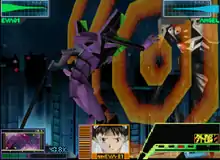Neon Genesis Evangelion (video game)
Neon Genesis Evangelion[lower-alpha 1], also known as Neon Genesis Evangelion 64,[1][2] is a 1999 fighting video game released for the Nintendo 64 in Japan by Bandai. It is based on the Gainax anime series of the same name and its 1997 film adaptation The End of Evangelion. Players control a cyborg named the Evangelion to destroy a race of aliens known as the Angels. The game is known for its alterations to the source material, featuring unique endings and plotlines not present in other Evangelion media.[2]
| Neon Genesis Evangelion | |
|---|---|
 | |
| Developer(s) | BEC |
| Publisher(s) | Bandai |
| Series | Neon Genesis Evangelion |
| Platform(s) | Nintendo 64 |
| Release |
|
| Genre(s) | Fighting |
| Mode(s) | Single player, Multiplayer |
Gameplay

The gameplay is mostly a fighting game between the Evas and Angels. There are three ways the player can play. The most common gameplays is Plain Fighting, where the player takes control of an Eva on a "3D-2D" Course, walking back and forth, attacking the enemy. The battles are mainly focused on pressing correct commands to activate cinematic attacks and grabs known as "Actions", while basics attacks are secondary. Another gameplay style used in the game is weponring. Various parts of the game include minigames as missions, where the player takes control of the Eva's weponring in order to accomplish a mission or objective. The final gameplay element used is free-for-all, where the player is still on a "3D-2D" Plane, but can move freely back and forth. This mode is used in missions 12, 12.5 and 13.
There are also modes outside the missions, such as a training mode named Simulation Mode. In this mode the player selects an Eva that has been unlocked in story mode and practices by shooting un-collared poly-models of different Angels, including ones that are not featured in the Story Mode, and receive a ranking based on how many Angel models are destroyed and how many shots are fired. It is possible to activate a Vs mode by using cheat codes, in which two players can select Evas with different weapons. The other unlockable modes are a sound test and Action Viewer, where the player can review all the Actions executed during the game.
Reception
According to Famitsu, Evangelion 64 sold over 38,000 copies by the end of 1999.[7] Critics were divided on the quality of Evangelion 64's gameplay. A preview from IGN highlighted its action sequences and visuals that closely resembled the television series, though commented on its lack of player input.[8] Christian Nutt of GameSpot believed the game's redeeming qualities were overshadowed by the poor quality of the gameplay itself: "The serious problem here is that the game fails to do what a game should do — deliver an engaging play experience." Nutt was unimpressed with its fighting and button tapping sequences, which he compared to games like Dragon's Lair and PaRappa the Rapper.[6]
Four reviewers for Famitsu gave the game a score of 29 out of 40.[3] N64 Magazine gave the game a rating of 61% and highlighted its stylized graphics, but criticized the lack of real gameplay, stating that Neon Genesis Evangelion is "simply a cut-down, 'interactive' version" of the anime series.[9]
Gamers' Republic gave the game a score of B+.[10] Gamers Republic listed the game in the 1999 Video Game Buyers Guide and Y2K Preview as one of the best games to import from Japan that year along with such games as, Bangai-O, The Adventure of Little Ralph, Pepsiman, Robot Dandy, and Internal Section.[11]
References
- Eisenbeis, Richard (November 16, 2012). "Evangelion 64: An Ancient Tale of Importing During the Dawn of the Internet". Kotaku. G/O Media. Archived from the original on November 13, 2020. Retrieved February 2, 2021.
- Gramuglia, Anthony (July 3, 2019). "Neon Genesis Evangelion Has Some Truly Bizarre Spinoffs". Comic Book Resources. Valnet. Archived from the original on March 19, 2020. Retrieved February 2, 2021.
- "新世紀エヴァンゲリオン [NINTENDO64]". Famitsu. Retrieved 2019-02-25.
- "Frontlines News - Evangelion Goes Polygonal On N64!". Gamers' Republic. Vol. 1 no. 7. Millennium Publishing. December 1999. p. 8.
- Lockhart, Ryan (January 1999). "Tokyo Game Show - Evangelion - Beat Down Shinji". Gamers' Republic. Vol. 1 no. 8. Millennium Publishing. p. 105.
- Nutt, Christian (July 16, 1999). "Neon Genesis Evangelion (Import) Review". GameSpot. CBS Interactive. Archived from the original on May 12, 2019. Retrieved February 1, 2021.
- "Game Search (based on Famitsu data)". Game Data Library. 1 March 2020. Archived from the original on 24 April 2019. Retrieved 16 March 2020.
- IGN Staff (June 25, 1999). "Neon Genesis Evangelion". IGN. Archived from the original on August 27, 2016. Retrieved February 3, 2021.
- Bickham, Jes (November 1999). "Neon Genesis Evangelion". N64 Magazine. No. 34. Future Publishing. p. 68.
- "World Republic Review: Evangelion". Gamers' Republic. Vol. 2 no. 4. Millennium Publishing. September 1999. p. 89.
- "Best of Imports '99". Millennium Presents: 1999 Video Game Buyers Guide and Y2K Preview. Millennium Publications. 1999. p. 116.